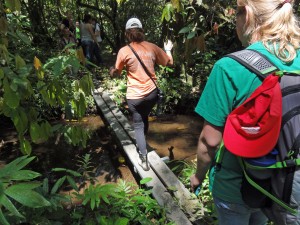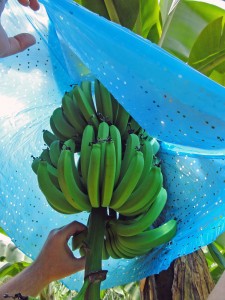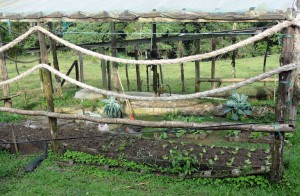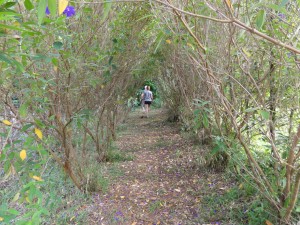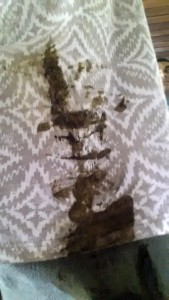Note: Many more photos are at the bottom of this post. You can click on any photo to see it larger.
This morning was a hike through a forested nature trail on the grounds of Earth University. One of my goals this trip was to keep up with the undergrads who are half my age, and so far I’m doing okay. Either I’m in better shape than I thought or they are in worse. I felt pretty good this morning and hope that lasts. It helps that in getting a decent amount of exercise this trip. Most of the time at home I’m on the computer for work or school or social media and personal email, which really takes a toll after a few days.
Banana tour
Also this morning was a tour of the banana plantation at Earth University, and of the packing and shipping house where workers sort, clean and box the bananas to go to Whole Foods. Today they were being shipped to the Whole Foods in Jessup, MD. This was so interesting and fulfilling to see. The values of the organization are printed in large letters on the outside of the building. This is a fair trade shop where the workers work an 8 hour shift with lunch and coffee breaks. The work looked very hard even so — I can’t imagine the exploitation that must go on in a shop that isn’t fair trade, which most are not.
The tour made me happy and a little proud that these are the bananas I buy. We first started shopping at Whole Foods because unlike most grocery stores, it has animal welfare standards. I’m willing to pay more for this, and for sustainable standards on seafood and fair trade on products like bananas. Of course this can come at a price. Our guide Mario thought it was pretty funny that the nickname of Whole Foods is “whole paycheck.” I hope someday we can move into a place where I can have a vegetable garden like the one at our home stay location, and we can grow more of our own food. In the meantime, I’d like to start ordering vegetables from a CSA.
Home stays
The home stays will be the true experience of Costa Rica. I’m staying with three other students at a small working farm called Laurel’s with Lidia and Fernando. Besides the garden, they have a horse, several chickens and a very friendly turkey, a pig, about 15 head of beef cattle, a couple of milk cows, and a pond full of fish. We started our tour of the farm by taking turns riding Fernando’s very sweet and well-behaved horse. She was so tolerant of us who haven’t ridden in ages — and who had a little trouble getting on.
Then we walked down the mountainside where Fernando keeps his beef cattle. One of the cows tends to walk and graze with part of his front legs on the ground. Fernando said the cow has a worm, and that he had given the cow a shot. But this made me wonder what kind of veterinary care these animals get. Does someone from Earth University travel to farms to take care of them? Earth has an animal farm because we visited it. I didn’t think to ask there what kind of veterinary care those animals get, but hopefully they have some kind of veterinary program there, even if it is not as developed as the one at Ohio State.
The other notable thing about Lidia and Fernando’s farm is the howler monkeys in the back yard. As we were touring the farm, we heard them hooting to each other a lot, so Fernando walked us over to the trees where they live and threw in a few sticks to get them to come out where we could see them. It worked. We saw four or five on various tree branches howling a lot at us.
I was surprised how small they are based on how loud the sound they make is – so they live up to their name. The males have a special vocal sac in their throat that helps them amplify the sound they make, which sounds like a strong wind running through a tunnel. I did wonder what the monkeys on Fernando’s farm were trying to tell us – was it a greeting or more of a warning to tell us to get out of their territory? I’m guessing the latter – that’s what it sounded like. I hope we didn’t stress them out too much, but living next to a farm, they have to be pretty used to interactions with humans.
Nature reserve photos

Mario tells us how the tree roots buttress out above ground because the tropical soil is so shallow.
Banana tour photos
Home stay photos



